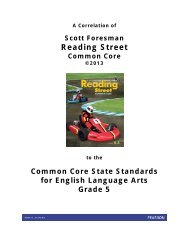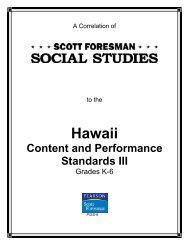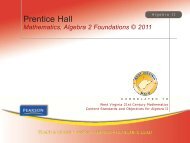myWorld Geography, Eastern Hemisphere - Pearson
myWorld Geography, Eastern Hemisphere - Pearson
myWorld Geography, Eastern Hemisphere - Pearson
You also want an ePaper? Increase the reach of your titles
YUMPU automatically turns print PDFs into web optimized ePapers that Google loves.
Textbook Alignment to the Utah Core – World HistoryThis alignment has been completed using an “Independent Alignment Vendor” from the USOE approved list(www.schools.utah.gov/curr/imc/indvendor.html.) Yes __X___ No _____Name of Company and Individual Conducting Alignment:McHugh & Associates, Inc.A “Credential Sheet” has been completed on the above company/evaluator and is (Please check one of the following):X On record with the USOE.□ The “Credential Sheet” is attached to this alignment.Instructional Materials Evaluation Criteria (name and grade of the core document used to align): Social Studies, Sixth Grade WorldHistory Core Curriculum________________________________Title: <strong>myWorld</strong> <strong>Geography</strong>, <strong>Eastern</strong> <strong>Hemisphere</strong> © 2011 ____________ ISBN#: 0-13-251962-3_________________________________Publisher: <strong>Pearson</strong> Publishing as Prentice Hall__________________________________________________________________________Overall percentage of coverage in the Student Edition (SE) and Teacher Edition (TE) of the Utah State Core Curriculum:_________100___%Overall percentage of coverage in ancillary materials of the Utah Core Curriculum: _____________0____%STANDARD I: Students will understand how ancient civilizations developed and how they contributed to the current state of the world.Percentage of coverage in the student and teacher edition forStandard I:_____________100 %Percentage of coverage not in student or teacher edition, butcovered in the ancillary material for Standard I: ________________0%
OBJECTIVES & INDICATORSObjective 1: Explain why physical geography affected thedevelopment of early civilizations.a. Identify the major physical features of the regionswhere ancient civilizations flourished.Coverage in Student Edition(SE) and Teacher Edition (TE) (pg #’s,etc.)SE: 340-341, 346-349, 372-373,390-391, 404-407, 410-413, 422-423, 444-447, 464, 478-483, 486-489, 514-519, 556-558, 586-591,597, 630-633, 664-666, 696-697,698-700, 736-737Coverage in AncillaryMaterial (titles, pg #’s, etc.)Not coveredin TE, SE orancillariesb. Describe how these features influenced the success ordecline of the civilizations.SE: 340-341, 346-349, 372-373,390-391, 404-407, 410-413, 422-423, 464, 478-483, 486-489, 514-519, 556-558, 586-591, 630-633,664-666, 698-700c. Compare maps of these ancient civilizations to currentpolitical maps and make inferences about the continuingaffects of physical geography on cultural development.SE: 124, 128, 134, 270-271, 322,340, 426, 432, 445, 515, 516, 538,557, 574, 588, 601, 612, 618, 652,686, 699, 718, 724Objective 2: Evaluate how religion has played a central role in humanhistory from ancient times to today.a. Explore the importance of religion in the culturalexpression of ancient civilizations (e.g. customs, artisticexpression, creation stories, architecture of sacred spaces).SE: 92-93, 353, 381, 446-447, 454-455, 476-477, 479-482, 500, 512-513, 534b. Identify key tenets of the major world religions (i.e.Buddhism, Christianity, Hinduism, Islam, Judaism).SE: 92-93, 446-447, 454-455, 479-482, 500, 513, 585, 587-589, 632-633, 636-637, 705
c. Analyze how religious ideas influence current issues. SE: 92-93, 442-443, 446-447, 454-455, 476-477, 479-482, 500, 512-513, 534Objective 3: Explain how modern governments can trace some oftheir attributes to the systems of power, authority, and governanceestablished in ancient civilizations.a. Identify forms of government within these civilizations. SE: 104-105, 106-107, 139, 140-141, 405, 515b. Compare those forms to existing systems of governance intoday’s world.SE: 104-105, 106-107, 108-109,302-305, 383, 418-419, 460-463,490-491, 522, 526, 534, 603, 604-605, 608, 634-635, 650, 674-675,680-681, 706, 744Objective 4: Analyze how the earliest civilizations createdtechnologies and systems to meet community and personal needs.a. Identify innovations in manmade structures over time (e.g.SE: 97, 98-99, 148, 581irrigation, roads, building materials) and their influence onmeeting needs.b. Examine the evolution and importance of writing. SE: 98, 148, 157, 405, 412-413,444, 446, 665c. Identify cultural expressions that reflect these systems (e.g.architecture, artistic expression, medicine, philosophy,drama, literature).d. Compare social classes, vocations, and gender roles withinancient civilizations.SE: 84-85, 86-87, 90-91, 94-95,96-97, 100-101, 353, 378, 458,487-489, 586-587, 596, 702-703,704-705SE: 144-145, 161, 162-163, 587,643
Sixth Grade Standard II: Students will understand the transformation of cultures during the Middle Ages and the Renaissance and theimpact of this transformation on modern times.Percentage of coverage in the student and teacher edition forStandard II: _____________100 %Percentage of coverage not in student or teacher edition, butcovered in the ancillary material for Standard II: ________________0%OBJECTIVES & INDICATORSObjective 1: Explain how physical geography affects economic andcultural expansion.a. Identify natural resources and physical features thataffected expansion.b. Describe the development of international trade via thedesert, sea, and land and the resultant cultural exchangesbetween Asia, the Middle East, and Europe (e.g. the SilkRoad)Objective 2: Explore the importance of religion in the Middle Agesand the Renaissance and its relevance to modern times.a. Explain the influence of religion on cultural expression(e.g. the arts, architecture, government, education, familystructure).b. Compare relations between the Muslim, Christian, andJewish faiths during the Middle Ages, Renaissance, andthe modern world (e.g. Crusades, periods of peacefulcoexistence, periods of conflict).Objective 3: Examine how systems of governance began steps towardself-rule during the Middle Ages and the Renaissance.a. Examine relationships between significant events andideas and their influence on systems of government (e.g.the rise of the merchant class, the Magna Carta, the impactof the Black Death, Germanic tribes, feudalism, manors,city-states).Coverage in Student Edition(SE) and Teacher Edition (TE) (pg #’s,etc.)SE: 188-193, 584-585, 693-695SE: 164-168, 448, 556-557, 560-561, 584-585, 589, 591, 696-697,698-700, 704-705SE: 159-160, 182-185, 270-273,585, 586-591, 696-697, 705SE: 164-168, 182-185SE: 167-171, 172b. Compare individual rights of people in the United States SE: 112-113, 168-170, 172, 196-Coverage in AncillaryMaterial (titles, pg #’s, etc.)Not coveredin TE, SE orancillaries
today with the rights of selected groups in the Middle Ages 199and the Renaissance (e.g. serfs, nobility, merchant class).Objective 4: Explain the importance of the Renaissance as a rebirth ofcultural and intellectual pursuits.a. Investigate how technological and scientific developmentsof the time promoted literacy and the exchange of ideas SE: 194-196that continue to this day (e.g. moveable type, telescope,microscope).b. Identify leading Renaissance artists and thinkers and theircontributions to visual arts, writing, music, andSE: 178-185, 218architecture (e.g. Machiavelli, Michelangelo, Leonardo daVinci, Palestrina, Shakespeare, Tallis).Sixth Grade Standard III: Students will understand how revolutions have had an impact on the modern world.Percentage of coverage in the student and teacher edition forStandard III: _____________100 %Percentage of coverage not in student or teacher edition, butcovered inthe ancillary material for Standard III: ________________0%OBJECTIVES & INDICATORSObjective 1: Understand processes of revolution.a. Examine social, religious, and economic issues that maylead to revolution.b. Identify and compare how revolutions develop in multipleareas of human life (e.g. scientific, agricultural, industrial,political, medical).Objective 2: Analyze the impact of selected revolutions.a. Identify representative people from selected revolutions(e.g. Napoleon, Martin Luther, James Watt, Isaac Newton,Madame Curie, Anton Van Leeuwenhoek).b. Examine the outcomes of selected revolutions (e.g. theScientific and Industrial revolutions, the Reformation, theFrench Revolution).Coverage in StudentEdition(SE) andTeacher Edition (TE) (pg #’s,etc.)SE: 196-197, 212, 218, 647-649SE: 194-199, 218, 647-619SE: 194-199, 218, 647-619SE: 195, 196, 197, 199, 218, 649Coverage in AncillaryMaterial(titles, pg #’s, etc.)Not coveredin TE, SE orancillaries
Sixth Grade Standard IV: Students will understand current global issues and their rights and responsibilities in the interconnected world.Percentage of coverage in the student and teacher edition forStandard IV: _____________100 %Percentage of coverage not in student or teacher edition, butcovered in the ancillary material for Standard IV: ________________0%OBJECTIVES & INDICATORSObjective 1. Analyze how major world events of the 20th centuryaffect the world today.a. Identify key events, ideas, and leaders of the 20th century(e.g. World War I, World War II, the Cold War, theKorean and Vietnamese conflicts, dynamic Asianeconomies).Coverage in Student Edition(SE) and Teacher Edition (TE) (pg #’s,etc.)SE: 200-205, 206-207, 382-383,391, 494-496, 498-499, 500-501,528-529, 593, 601, 668, 700-701b. Describe the impact of these events on the world today. SE: 200-205, 206-207, 382-383,391, 494-496, 498-499, 500-501,528-529, 593, 601, 668-669, 700-701Coverage in AncillaryMaterial (titles, pg #’s, etc.)Not coveredin TE, SE orancillariesObjective 2: Explore current global issues facing the modern worldand identify potential solutions.a. Investigate pressing issues facing the world today (e.g.environmental, pollution, political turmoil, hunger,poverty, genocide, famine, natural disasters, child labor).SE: 47, 50-51, 52-53, 54-55, 200-205, 206-207, 369, 382-383, 391,400-401, 494-496, 498-499, 500-501, 528-529, 564, 593, 599, 601,645, 663, 668, 700-701, 710-713b. Identify potential solutions to pressing issues. SE: 54, 70, 82, 114, 214-215, 218,318, 422, 534, 608, 714, 756-757c. Identify individuals and groups making positive changes inthe world today and support these choices with evidence.SE: 47, 70, 82, 103, 114, 219, 256-257, 284-285, 422-423, 534-535,575-577, 609
Objective 3: Determine human rights and responsibilities in theworld.a. Identify rights considered essential for all humans (e.g.health care, education, safety, freedom from fear, freedomof expression).b. Propose steps individual students can take to protect theserights (e.g. support for sister schools, energy and resourceconservation, letter writing, career choices, fundraisingefforts).SE: 113, 284-285, 535, 608, 757SE: 285, 535, 609

















